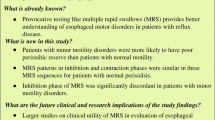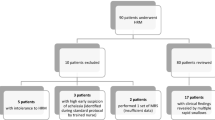Abstract
Background
When multiple swallows are rapidly administered, esophageal peristalsis is inhibited, and pronounced lower esophageal sphincter relaxation ensues. After the last swallow of the series, a robust contraction sequence results. The authors hypothesize that multiple rapid swallows (MRS) may have value in predicting esophageal transit symptoms in patients undergoing laparoscopic antireflux surgery (LARS).
Methods
Records of patients undergoing esophageal high-resolution manometry (HRM) before LARS were evaluated. The evaluation of MRS included adequate inhibitory response during swallows and the contraction pattern after MRS. Dysphagia was scored based on a product of symptom frequency and severity using 5-point Likert scales. A composite dysphagia score comprised the sum of scores for solid and liquid dysphagia, and a score of 4 or higher was considered clinically significant. The normal and abnormal MRS responses of patients with preoperative, early, and late postoperative dysphagia were compared with those of patients with no dysphagia.
Results
In this study, 63 patients (mean age, 60.3 ± 1.7 years, 48 women) undergoing HRM before LARS successfully performed MRS (median, 5 swallows; longest interval between swallows, 3.2 ± 0.1 s). After MRS, 14 patients (22.2 %) had an intact peristaltic sequence. Complete failure of peristalsis was seen in 21 (33.3 %), and incomplete esophageal inhibition in 25 (39.7 %) of the remaining patients. When stratified by presence or absence of dysphagia, 58.3 % of the subjects without dysphagia had a normal MRS response, whereas 83.3 % had formation of peristaltic segments after MRS. In contrast, only 14 % of the subjects with dysphagia had a normal MRS response (p ≤ 0.003 vs. the subjects with no dysphagia). Abnormal MRS responses were more prevalent in the patients with any preoperative and late postoperative dysphagia (p = 0.04 across groups) and in those with clinically significant dysphagia (p = 0.08 across groups).
Conclusions
High-resolution manometry with MRS helps to predict dysphagia in subjects undergoing preoperative esophageal function testing before LARS.



Similar content being viewed by others
References
Rohof W, Bisschops R, Tack J (2011) Postoperative problems 2011: fundoplication and obesity surgery. Gastroenterol Clin North Am 40:809–821
Chan W, Haroian L, Gyawali C (2011) Value of preoperative esophageal function studies before laparoscopic antereflux surgery. Surg Endosc 25:2943–2949
Fornari F, Bravi I, Pengani R et al (2009) Multiple rapid swallowing: a complementary test during standard oesophageal manometry. Neurogastroenterol Motil 21:718–725
Pandolfino J, Kahrilas P (2005) AGA technical review on the clinical use of esophageal manometry. Gastroenterology 128:209–224
Gyawali C, Kushnir V (2011) High-resolution manometric characteristics help differentiate types of distal esophageal obstruction in patients with peristalsis. Neurogastroenterol Motil 6:502–509
Porter R, Gyawali C (2011) Botulinum toxin injection in dysphagia syndromes with preserved esophageal peristalsis and incomplete lower esophageal sphincter relaxation. Neurogastroenterol Motil 23:139–144
Wu J, Dunnegan D, Luttman D et al (1996) Influence of surgical technique on clinical outcome of laparoscopic nissen fundoplication. Surg Endosc 10:1164–1169
Anvari M, Allen C (1998) Esophageal and lower esophageal sphincter pressure profiles 6 and 24 months after laparoscopic fundoplication and their association with postoperative dysphagia. Surg Endosc 12:421–426
Hunter J, Trus T, Branum G et al (1996) A physiologic approach to laparoscopic fundoplication for gastroesophageal reflux disease. Ann Surg 6:673–687
Winslow E, Clouse R, Desai K et al (2003) Influence of spastic motor disorders of the esophageal body on outcomes from laparoscopic antereflux surgery. Surg Endosc 17:738–745
Richter J, Barisch C, Castell D (1986) Abnormal sensory perception in patients with esophageal chest pain. Gastroenterology 91:845–852
Borjesson M, Pilhall M, Eliasson T et al (1998) Esophageal visceral pain sensitivity: effects of TENS and correlation with manometric findings. Dig Dis Sci 8:1621–1628
Sifrim D, Janssens J, Vantrappen G (1994) Failing deglutitive inhibition in primary esophageal motility disorders. Gastroenterology 106:875–882
Disclosures
L. Michael Brunt has received honoraria for speaking and teaching from Ethicon Endosurgery and Lifecell Corporation. C. Prakash Gyawali has received honoraria for speaking and research support from Given Imaging. Nathaniel Stoikes, Jesse Drapekin, Vladimir Kushnir, and Anisa Shaker have no conflicts of interest or financial ties to disclose.
Author information
Authors and Affiliations
Corresponding author
Additional information
Accepted for a podium presentation at the Annual Society of American Gastrointestinal Endoscopic Surgeons (SAGES) Meeting, 2012.
Rights and permissions
About this article
Cite this article
Stoikes, N., Drapekin, J., Kushnir, V. et al. The value of multiple rapid swallows during preoperative esophageal manometry before laparoscopic antireflux surgery. Surg Endosc 26, 3401–3407 (2012). https://doi.org/10.1007/s00464-012-2350-0
Received:
Accepted:
Published:
Issue Date:
DOI: https://doi.org/10.1007/s00464-012-2350-0




